Assessment of Social Environment Competitiveness in Terms of Security in the Baltic Capitals
Abstract
1. Introduction
2. Related Literature Analysis
2.1. Sustainable Social Environment and Its Security
2.2. Urban Competitiveness and Its Assessment
3. Methodology
4. Research
5. Discussion
6. Conclusions
Author Contributions
Funding
Institutional Review Board Statement
Informed Consent Statement
Data Availability Statement
Conflicts of Interest
References
- Arbušauskaitė, N.; Juščenko, A.L. The Social-Demographic Analysis of Cemetery Data: Particularity and Results. Reg. Form. Dev. Stud. 2013, 2, 6–17. [Google Scholar] [CrossRef][Green Version]
- Li, Y.; Qin, M. Study on urbanization process evaluation and provincial comparison. Grey Syst. Theory Appl. 2014, 4, 13–23. [Google Scholar] [CrossRef]
- Connolly, C.; Keil, R.; Ali, S.H. Extended urbanisation and the spatialities of infectious disease: Demographic change, infrastructure and governance. Urban Stud. 2021, 58, 245–263. [Google Scholar] [CrossRef]
- Henderson, J.V.; Storeygard, A.; Weil, D.N. Measuring Economic Growth from Outer Space. Am. Econ. Rev. 2012, 102, 994–1028. [Google Scholar] [CrossRef]
- Singhal, S.; Berry, J.; McGreal, S. A Framework for Assessing Regeneration, Business Strategies and Urban Competitiveness. Local Econ. J. Local Econ. Policy Unit 2009, 24, 111–124. [Google Scholar] [CrossRef]
- Xu, B.; Watada, J. Identification of regional urbanization gap: Evidence of China. J. Model. Manag. 2008, 3, 7–25. [Google Scholar] [CrossRef]
- Witcher, P. The World Urban Forum: Ideas on the Future of the World’s Cities; UN Chron: New York, NY, USA, 2006; Volume 2. [Google Scholar]
- Wolf, M. Rethinking Urban Epidemiology: Natures, Networks and Materialities. Int. J. Urban Reg. Res. 2016, 40, 958–982. [Google Scholar] [CrossRef]
- Žalevičienė, A.; Čiegis, R. Darnus miestų vystymasis ir europos sąjungos investicijų įsisavinimas. Manag. Theor. 2012, 1, 42–51. [Google Scholar]
- Rutkauskas, A.V. On the Sustainability OF Regional Competitiveness Development Considering Risk/Apie Regiono Konkurencingumo Plėtros Tvarumą Atsižvelgiant Į Riziką. Technol. Econ. Dev. Econ. 2008, 14, 89–99. [Google Scholar] [CrossRef]
- Zhao, C.-R.; Zhou, B.; Su, X. Evaluation of Urban Eco-Security—A Case Study of Mianyang City, China. Sustainability 2014, 6, 2281–2299. [Google Scholar] [CrossRef]
- Ramanauskienė, J.; Čiegis, R. Integruotas darnaus vystymosi vertinimas: Lietuvos atvejis. Vadyb. Moksl. Stud. Kaimo Verslų Infrastruktūros Plėtrai 2011, 2, 39–49. [Google Scholar]
- Melnikas, B. Urbanizacijos procesai šiuolaikinių globalizacijos, Europos integracijos ir žinių visuomenės kūrimo iššūkių kontekste. Theor. Pract. J. 2013, 2, 23–41. [Google Scholar]
- Činčikaitė, R.; Paliulis, N. Assessing Competitiveness of Lithuanian Cities. Econ. Manag. 2013, 18, 490–500. [Google Scholar] [CrossRef][Green Version]
- Wu, J. Urban ecology and sustainability: The state-of-the-science and future directions. Landsc. Urban Plan. 2014, 125, 209–221. [Google Scholar] [CrossRef]
- Wei, Y.; Huang, C.; Lam, P.T.; Yuan, Z. Sustainable urban development: A review on urban carrying capacity assessment. Habitat. Int. 2015, 46, 64–71. [Google Scholar] [CrossRef]
- Pivorienė, J. Global Education and Social Dimension of Sustainable Development. Soc. Ugdym. 2014, 39, 39–47. [Google Scholar] [CrossRef]
- Marin, C.; Dorobanţu, R.; Codreanu, D.; Mihaela, R. The Fruit of Collaboration between Local Government and Private Partners in the Sustainable Development Community Case Study: County Valcea. Acad. Econ. Stud. Rom. 2012, 15, 93–98. [Google Scholar]
- Cioca, L.-I.; Ivascu, L.; Rada, E.C.; Torretta, V.; Ionescu, G. Sustainable Development and Technological Impact on CO2 Reducing Conditions in Romania. Sustainability 2015, 7, 1637–1650. [Google Scholar] [CrossRef]
- Estêvão, R.S.; Ferreira, F.A.; Rosa, Á.A.; Govindan, K.; Meidutė-Kavaliauskienė, I. A socio-technical approach to the assessment of sustainable tourism: Adding value with a comprehensive process-oriented framework. J. Clean. Prod. 2019, 236, 117487. [Google Scholar] [CrossRef]
- Newman, P.; Kenworthy, J. Sustainability and Cities: Overcoming Automobile Dependence; Island Press: Washington, DC, USA, 1999; pp. 219–226. [Google Scholar]
- Bruneckiene, J.; Guzavicius, A.; Činčikaitė, R. Measurement of Urban Competitiveness in Lithuania. Eng. Econ. 2010, 21, 493–508. [Google Scholar]
- Snieška, V.; Zykiene, I. The Role of Infrastructure in the Future City: Theoretical Perspective. Procedia-Soc. Behav. Sci. 2014, 156, 247–251. [Google Scholar] [CrossRef][Green Version]
- Barbier, E.B.; Burgess, J.C. The Sustainable Development Goals and the systems approach to sustainability. Econ. Open-Assess. E-J. 2017. [Google Scholar] [CrossRef]
- Panda, S.; Chakraborty, M.; Misra, S. Assessment of social sustainable development in urban India by a composite index. Int. J. Sustain. Built Environ. 2016, 5, 435–450. [Google Scholar] [CrossRef]
- Melnikas, B.; Tumalavičius, V.; Šakočius, A.; Bileišis, M.; Ungurytė-Ragauskienė, S.; Giedraitytė, V.; Prakapienė, D.; Guščin-skienė, J.; Čiburienė, J.; Dubauskas, G.; et al. Saugumo iššūkiai: Vadybos tobulinimas, Vilnius, Lithuania. 2000, pp. 1–494. Available online: https://vb.mruni.eu/object/elaba:76330940/76330940.pdf (accessed on 20 June 2021).
- Michailovič, I. Nusikalstamumo baimės šiuolaikinėje miesto visuomenėje problematika. Teisės Probl. 2012, 77, 53–71. [Google Scholar]
- Glassner, B. The Culture of Fear: Why Americans are Afraid of the Wrong Things; Hachette: London, UK, 2010. [Google Scholar]
- Balčaitė, S. Miesto Baimės Teritorinė Raiška: Uždarų Gyvenviečių Sklaida Lietuvoje; Vilnius, Lithuania. 2020, pp. 29–44. Available online: http://www.demografija.lt/download/03Balcaite_2020.pdf (accessed on 20 June 2021).
- Dzhamalova, B.B.; Magomedov, B.B.; Amirkhanov, G.B.; Ramazanova, A.A.; Suleymanov, P.K. Anthropological mechanisms of self-management of personality behavior. Int. Rev. Manag. Mark. 2016, 6, 383–389. [Google Scholar]
- Wang, J.; Long, R.; Chen, H.; Li, Q. Measuring the Psychological Security of Urban Residents: Construction and Validation of a New Scale. Front. Psychol. 2019, 10, 2423. [Google Scholar] [CrossRef]
- Foster, S.; Hooper, P.; Knuiman, M.; Giles-Corti, B. Does heightened fear of crime lead to poorer mental health in new suburbs, or vice versa? Soc. Sci. Med. 2016, 168, 30–34. [Google Scholar] [CrossRef]
- Curiel, R.P.; Bishop, S. Modelling the fear of crime. Proc. R. Soc. A Math. Phys. Eng. Sci. 2017, 473, 20170156. [Google Scholar] [CrossRef]
- Martin, M.; Maddocks, E.; Chen, Y.; Gilman, S.; Colman, I. Food insecurity and mental illness: Disproportionate impacts in the context of perceived stress and social isolation. Public Health 2016, 132, 86–91. [Google Scholar] [CrossRef]
- Tseng, K.K.; Park, S.H.; Shearston, J.A.; Lee, L.; Weitzman, M. Parental Psychological Distress and Family Food Insecurity: Sad Dads in Hungry Homes. J. Dev. Behav. Pediatr. 2017, 38, 611–618. [Google Scholar] [CrossRef]
- Newman, A.; Donohue, R.; Eva, N. Psychological safety: A systematic review of the literature. Hum. Resour. Manag. Rev. 2017, 27, 521–535. [Google Scholar] [CrossRef]
- Chen, J.; May, D.R.; Schwoerer, C.E.; Augelli, B. Exploring the Boundaries of Career Calling. J. Career Dev. 2016, 45, 103–116. [Google Scholar] [CrossRef]
- Carmeli, A. Social Capital, Psychological Safety and Learning Behaviours from Failure in Organisations. Long Range Plan. 2007, 40, 30–44. [Google Scholar] [CrossRef]
- Liu, S.; Hu, J.; Li, Y.; Wang, Z.; Lin, X. Examining the cross-level relationship between shared leadership and learning in teams: Evidence from China. Leadersh. Q. 2014, 25, 282–295. [Google Scholar] [CrossRef]
- Blynova, O.Y.; Holovkova, L.S.; Sheviakov, O.V. Philosophical and Sociocultural Dimensions of Personality Psychological Security. Anthr. Meas. Philos. Res. 2018, 73–83. [Google Scholar] [CrossRef]
- Lazutka, R.; Žalimienė, L.; Skučienė, D.; Ivaškaitė-Tamošiūnė, V. Šumskaitė, Socialinė Parama Lietuvoje: Remiamųjų Padėtis ir Paramos Rezultatai; Socialinių Tyrimų Institutas: Vilnius, Lithuania, 2008. [Google Scholar]
- Matulionytė, R.; Navickė, J. Sąlygų griežtumas socialinės paramos sistemose: Lietuvos ir kitų Europos Sąjungos šalių palyginimas. Soc. Teor. Emp. Polit. Prakt. 2018, 16, 7. [Google Scholar] [CrossRef]
- Aidukaitė, J.; Bogdanova, N.; Guogis, A. Gerovės Valstybės Kūrimas Lietuvoje: Mitas ar Realybė? Lietuvos Socialinių Tyrimų Centras: Vilnius, Lithuania, 2012. [Google Scholar]
- Paškevičiūtė, A.; Šileika, J. Lietuvos Tapsmo Gerovės Valstybe Prieštaros. Ekon. Vadyb. Aktualijos Perspekt. 2013, 1, 8–19. Available online: https://etalpykla.lituanistikadb.lt/object/LT-LDB-0001:J.04~2013~1372367063976/ (accessed on 20 June 2021).
- Balvočiūtė, R. Ar socialinės išmokos mažina gyventojų skurdą? Poveikio lyginamoji analizė senosiose ir Rytų Europos šalyse. Soc. Teor. Emp. Polit. Prakt. 2019, 18, 23–45. [Google Scholar] [CrossRef]
- Akizu-Gardoki, O.; Bueno, G.; Wiedmann, T.; Lopez-Guede, J.M.; Arto, I.; Hernandez, P.; Moran, D. Decoupling between human development and energy consumption within footprint accounts. J. Clean. Prod. 2018, 202, 1145–1157. [Google Scholar] [CrossRef]
- Gižienė, Ž.; Simanavičienė, V. Žmogiškųjų išteklių ekonominis vertinimas. Econ. Manag. 2009, 14, 237–245. [Google Scholar]
- Laima Okunevičiūtė-Neverauskienė, A.P. Gyventojų užimtumo pokyčių diferenciacijos. Reg. Form. Dev. Stud. 2017, 3, 71–85. [Google Scholar]
- Poot, J. Demographic Change and Regional Competitiveness: The Effects of Immigration and Ageing; University of Waikato: Hamilton, New Zealand, 2007; p. 17. [Google Scholar]
- Grigoriev, V.M.; Jasilionis, P.; Stumbrys, D.; Stankūnienė, D.; Shkolnikov, V. Individualand area-level characteristics associated with alcohol-related mortality among adult Lithuanian males: A multilevel analysis based on census-linked data. PLoS ONE 2017, 12, e0181622. [Google Scholar] [CrossRef]
- Jasilionis, D.; Stankūnienė, V.; Maslauskaitė, A.; Stumbrys, D. Lietuvos Demografinių Procesų Diferenciacija; Lithuanian Social Research Centre: Vilnius, Lithuania, 2015. [Google Scholar]
- Stankūnienė, V.; Baublytė, M.; Žibas, K.; Stumbrys, D. Lietuvos Demografinė Kaita. Ką Atskleidžia Gyventojų Surašymai; Kaunas: Vilnius, Lithuania, 2016. [Google Scholar]
- Stankūnienė, M.; Maslauskaitė, V.; Baublytė, A. Ar Lietuvos Šeimos Bus Gausesnės? Lietuvos Socialinių Tyrimų Centras: Vilnius, Lithuania, 2013. [Google Scholar]
- Klüsener, S.; Stankūnienė, V.; Grigoriev, P.; Jasilionis, D. Emigration in a Mass Emigration Setting: The Case of Lithuania. Int. Migr. 2015, 4, 1–15. [Google Scholar]
- Kanopienė, S.; Mikulionienė, V. Gyventojų senėjimas ir jo iššūkiai sveikatos apsaugos sistemai. Gerontologija 2006, 7, 188–200. [Google Scholar]
- Daumantas, S. Demografinių Pokyčių Įtaka Lietuvos Darbo Ištekliams; Lietuvos Socialinių Tyrimų Centras: Vilnius, Lithuania, 2017; pp. 11–22. [Google Scholar]
- Pylipavičius, V. Bendruomeninio verslumo formavimas ir kaimo vietovių konkurencingumo stiprinimas. Ekon. Vadyb. 2011, 4, 169–178. [Google Scholar]
- Ivanauskaitė, T. Demografinių veiksnių poveikis darniam vystymuisi. Inf. Moksl. 2012, 62, 67–80. [Google Scholar] [CrossRef]
- Lekavičiūtė, E.; Žibas, K. Darbo migracijos procesai Lietuvoje. Liet. Soc. Raida 2017, 6, 54–69. [Google Scholar]
- Činčikaitė, R.; Meidute-Kavaliauskiene, I. An Integrated Competitiveness Assessment of the Baltic Capitals Based on the Principles of Sustainable Development. Sustainability 2021, 13, 3764. [Google Scholar] [CrossRef]
- Piliutytė, J. Miestų konkurencingumo koncepcija ir analizės lygmenys. Viešoji Polit. Adm. 2007, 19, 81–89. [Google Scholar]
- Sinkienė, J. Miesto konkurencingumo veiksniai. Viešoji Polit. Adm. 2008, 25, 68–83. [Google Scholar]
- Ni, P.; Kresl, P.; Li, X. China urban competitiveness in industrialization: Based on the panel data of 25 cities in China from 1990 to 2009. Urban Stud. 2014, 51, 2787–2805. [Google Scholar] [CrossRef]
- Anttiroiko, A.-V.; Valkama, P.; Bailey, S.J. Smart cities in the new service economy: Building platforms for smart services. AI Soc. 2014, 29, 323–334. [Google Scholar] [CrossRef]
- Auci, S.; Mundula, L. Smart Cities and a Stochastic Frontier Analysis: A Comparison among European Cities. 2012. Available online: http://ssrn.com/abstract=2150839Electroniccopyavailableat:https://ssrn.com/abstract=2150839Electroniccopyavailableat:http://ssrn.com/abstract=2150839https://ssrn.com/abstract=2150839Electroniccopyavailableat:http://ssrn.com/abstract=2150839 (accessed on 7 April 2021).
- Bakıcı, T.; Almirall, E.; Wareham, J. A Smart City Initiative: The Case of Barcelona. J. Knowl. Econ. 2013, 4, 135–148. [Google Scholar] [CrossRef]
- Bojic, I.; Lipic, T.; Podobnik, V. Bio-Inspired Clustering and Data Diffusion in Machine Social Networks. Computational Social Networks; Springer: London, UK, 2012; pp. 51–79. [Google Scholar]
- Caragliu, A.; Del Bo, C.F.M.; Nijkamp, P. Smart Cities in Europe. J. Urban Technol. 2011, 18, 65–82. [Google Scholar] [CrossRef]
- Fernandez-Anez, V.; Fernández-Güell, J.M.; Giffinger, R. Smart City implementation and discourses: An integrated conceptual model. The case of Vienna. Cities 2018, 78, 4–16. [Google Scholar] [CrossRef]
- Bruneckienė, J. Šalies Regionų Konkurencingumo Vertinimas Įvairiais Metodais: Rezultatų Analizė ir Vertinimas. Econ. Manag. 2010, 15, 25–31. [Google Scholar]
- Bruneckienė, J.; Činčikaitė, R. Šalies regionų konkurencingumo vertinimas regionų konkurencingumo indeksu: Tikslumo didinimo aspektas. Ekon. Vadyb. 2009, 14, 700–709. [Google Scholar]
- Pabedinskaitė, A.; Činčikaitė, R. Peculiarities of evaluating urban competitiveness. Manag. Eng. 2015, 1, 475–483. [Google Scholar]
- Pabedinskaitė, A.; Karlas, A.; Činčikaitė, R. Evaluation of smart cities. Manag. Eng. 2016, 1, 273–283. [Google Scholar]
- Biermann, F.; Kanie, N.; Kim, R.E. Global governance by goal-setting: The novel approach of the UN Sustainable Development Goals. Curr. Opin. Environ. Sustain. 2017, 26–27, 26–31. [Google Scholar] [CrossRef]
- Campagnolo, L.; Carraro, C.; Eboli, F.; Farnia, L.; Parrado, R.; Pierfederici, R. The Ex-Ante Evaluation of Achieving Sustainable Development Goals. Soc. Indic. Res. 2017, 136, 73–116. [Google Scholar] [CrossRef]
- Hák, T.; Janoušková, S.; Moldan, B. Sustainable Development Goals: A need for relevant indicators. Ecol. Indic. 2016, 60, 565–573. [Google Scholar] [CrossRef]
- Shaaban, M.; Scheffran, J. Selection of sustainable development indicators for the assessment of electricity production in Egypt. Sustain. Energy Technol. Assess. 2017, 22, 65–73. [Google Scholar] [CrossRef]
- Shen, J.; Yang, X. Analyzing Urban Competitiveness Changes in Major Chinese Cities 1995–2008. Appl. Spat. Anal. Policy 2014, 7, 361–379. [Google Scholar] [CrossRef]
- Wang, J.; Wei, X.; Guo, Q. A three-dimensional evaluation model for regional carrying capacity of ecological environment to social economic development: Model development and a case study in China. Ecol. Indic. 2018, 89, 348–355. [Google Scholar] [CrossRef]
- Xavier, A.; Freitas, M.D.B.C.; Fragoso, R.; Rosário, M.D.S. A regional composite indicator for analysing agricultural sustainability in Portugal: A goal programming approach. Ecol. Indic. 2018, 89, 84–100. [Google Scholar] [CrossRef]
- Servetkienė, V. Lietuvos Gyventojų Gyvenimo Kokybės Pokyčiai: Statistika ir Real Ybė. Soc. Innov. Glob. Growth 2012, 1, 792–815. Available online: https://etalpykla.lituanistikadb.lt/object/LT-LDB-0001:J.04~2012~1367189104253/ (accessed on 20 June 2021).
- Ginevičius, R.; Podvezko, V.; Mikelis, D. Quantitative Evaluation of Economic and Social Development of Lithuanian Regions. Ekonomika 2004, 65, 67–81. [Google Scholar] [CrossRef]
- Lazauskas, M.; Zavadskas, E.K.; Šaparauskas, J. Ranking of priorities among the baltic capital cities for the development of sustainable construction. E+M Èkon. Manag. 2015, 18, 15–24. [Google Scholar] [CrossRef]
- Zavadskas, E.K.; Turskis, Z. Multiple Criteria Decision Making (Mcdm) Methods in Economics: An Overview/Daugiatiksliai Sprendimų Priėmimo Metodai Ekonomikoje: Apžvalga. Technol. Econ. Dev. Econ. 2011, 17, 397–427. [Google Scholar] [CrossRef]
- Ginevičius, R.; Podvezko, V. The problem of compatibility of various multiple criteria evaluation methods. Bus. Theory Pract. 2008, 9, 73–80. [Google Scholar] [CrossRef]
- Bruneckiene, J.; Činčikaitė, R.; Kilijonienė, A. The Specifics of Measurement the Urban Competitiveness at the National and International Level. Eng. Econ. 2012, 23, 256–270. [Google Scholar] [CrossRef]
- Akande, A.; Cabral, P.; Gomes, P.; Casteleyn, S. The Lisbon ranking for smart sustainable cities in Europe. Sustain. Cities Soc. 2019, 44, 475–487. [Google Scholar] [CrossRef]
- Stanković, J.; Džunić, M.; Džunić, Ž.; Marinković, S. A Multi-Criteria Evaluation of the European Cities’ Smart Performance: Economic, Social and Environmental Aspects. J. Econ. Bus. 2017, 35, 519–550. [Google Scholar] [CrossRef]
- Bolívar, M.P.R. In the search for the ‘Smart’ Source of the Perception of Quality of Life in European Smart Cities. 2019, Volume 1, pp. 3325–3334. Available online: https://scholarspace.manoa.hawaii.edu/handle/10125/59768 (accessed on 7 April 2021). [CrossRef]
- Gil, M.T.N.; Carvalho, L.; Paiva, I. Determining factors in becoming a sustainable smart city: An empirical study in Europe. Econ. Sociol. 2020, 13, 24–39. [Google Scholar] [CrossRef]
- Meidutė-Kavaliauskienė, I.; Dudzevičiūtė, G.; Maknickienė, N. Military and Demographic Inter-Linkages in The Context of the Lithuanian Sustainability. J. Bus. Econ. Manag. 2020, 21, 1508–1524. [Google Scholar] [CrossRef]
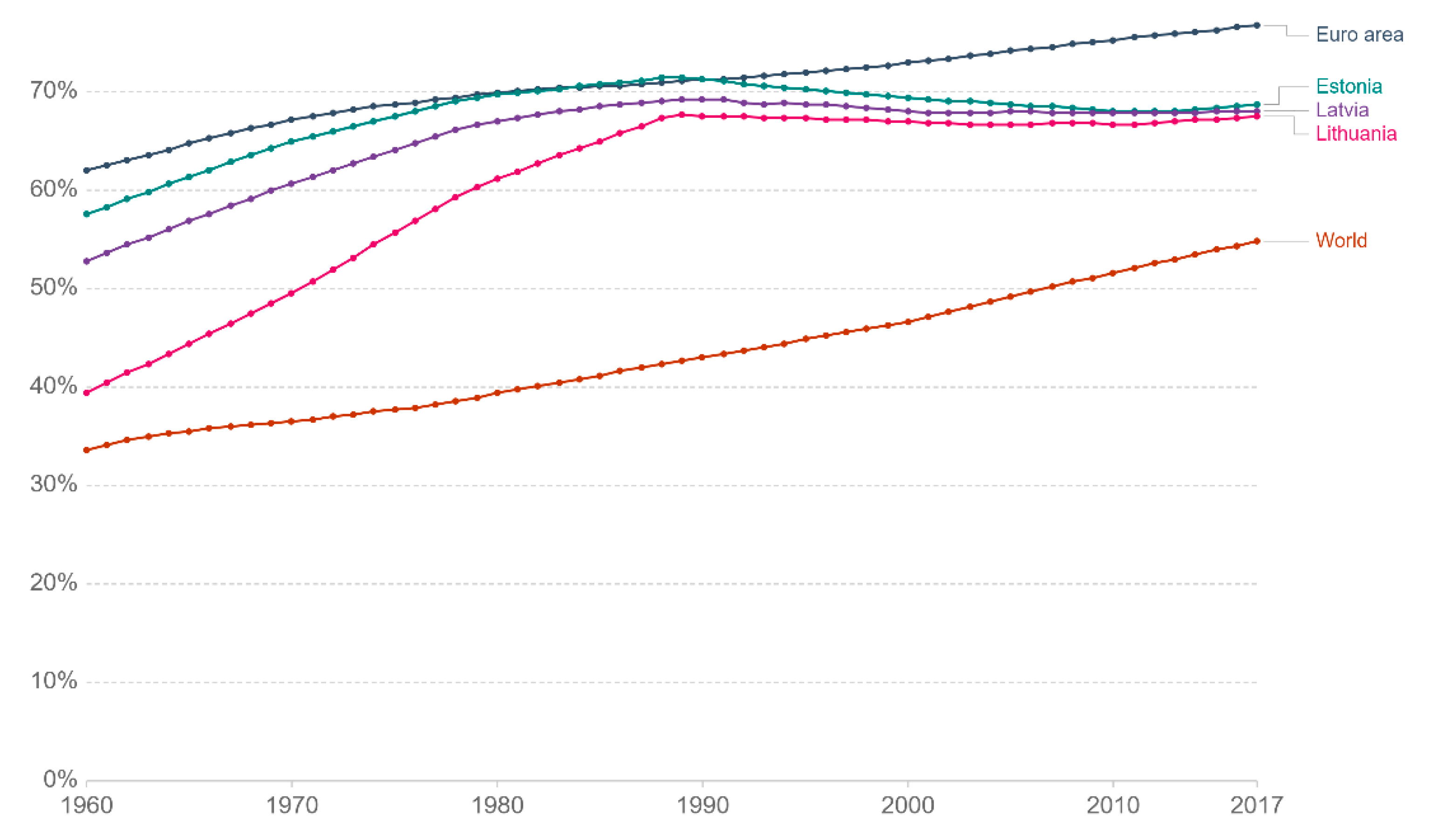
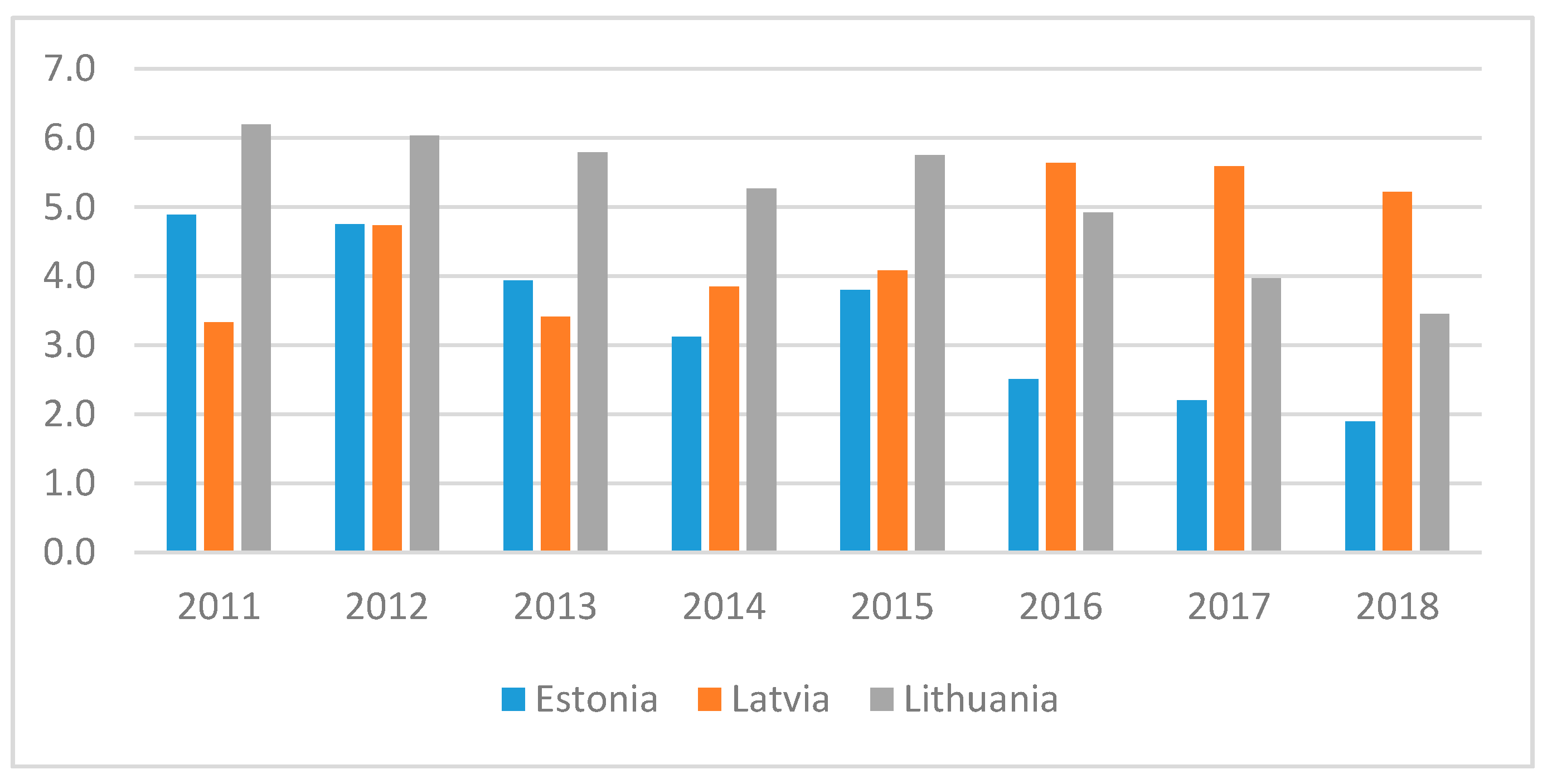
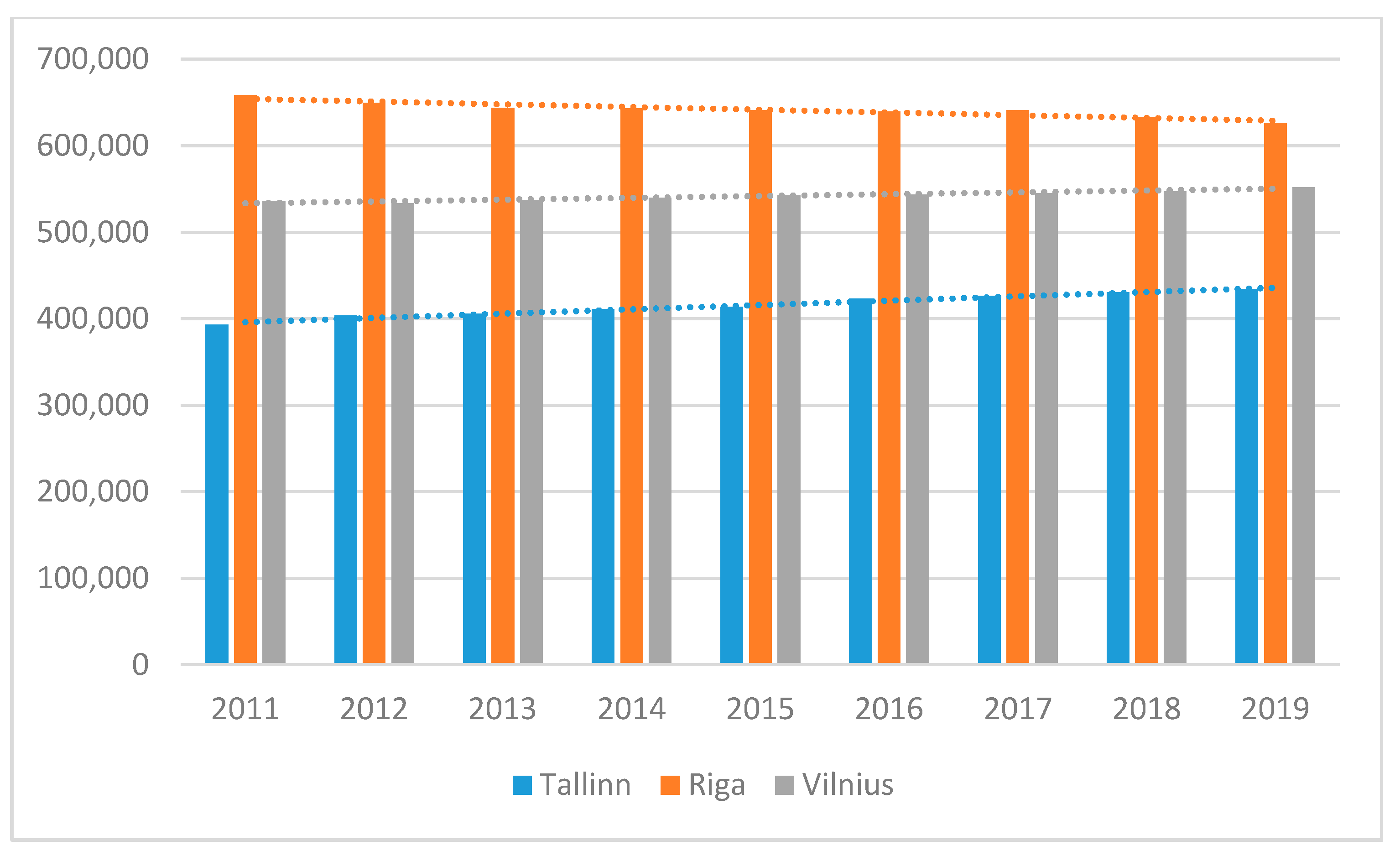
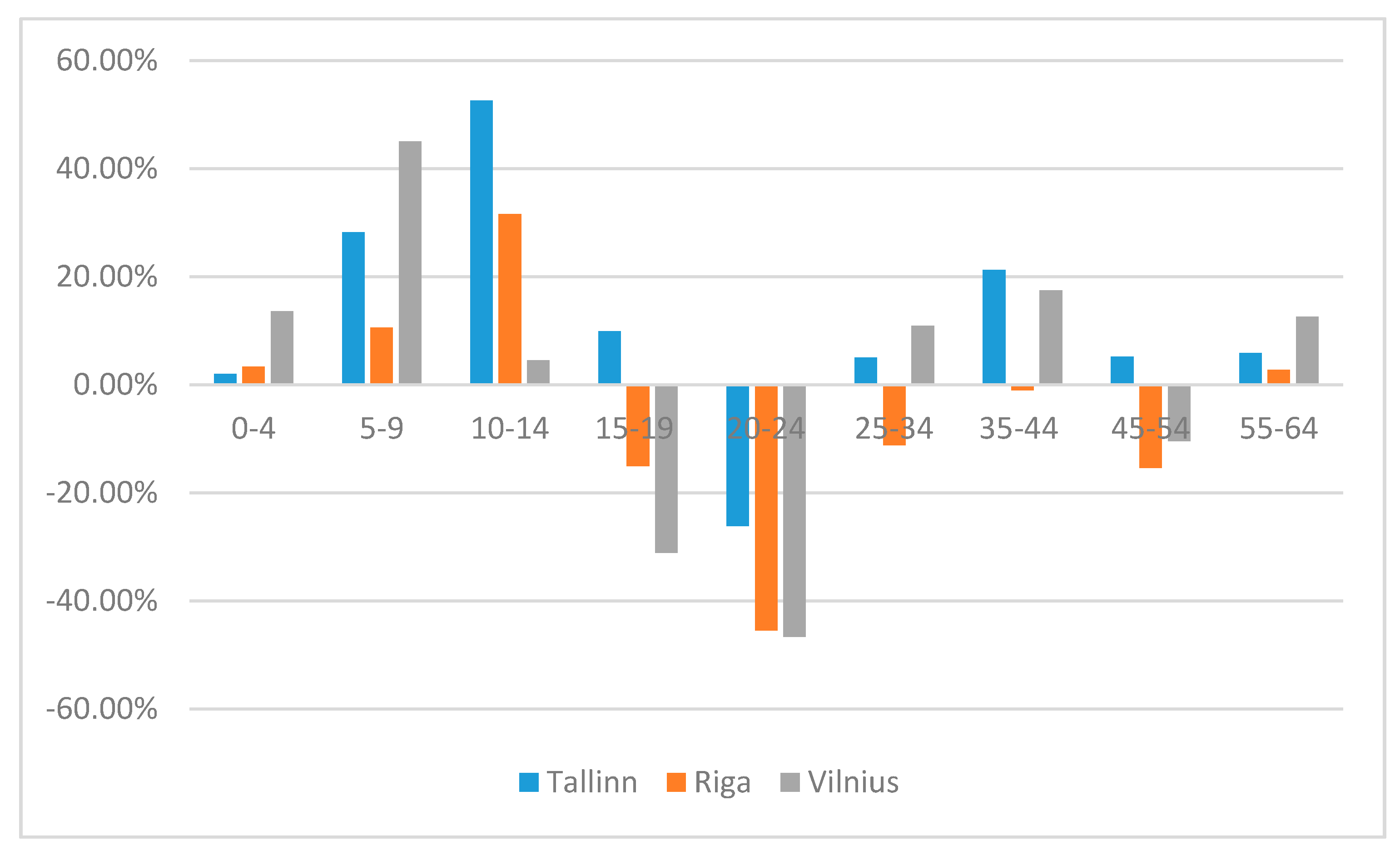
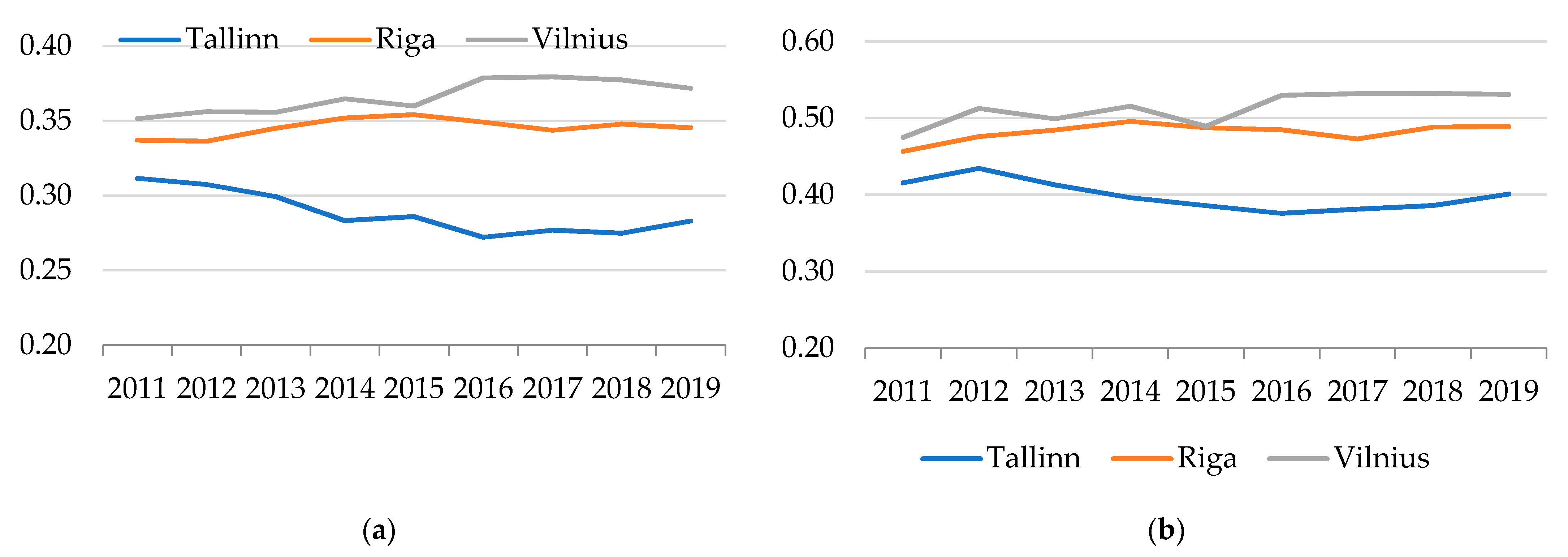

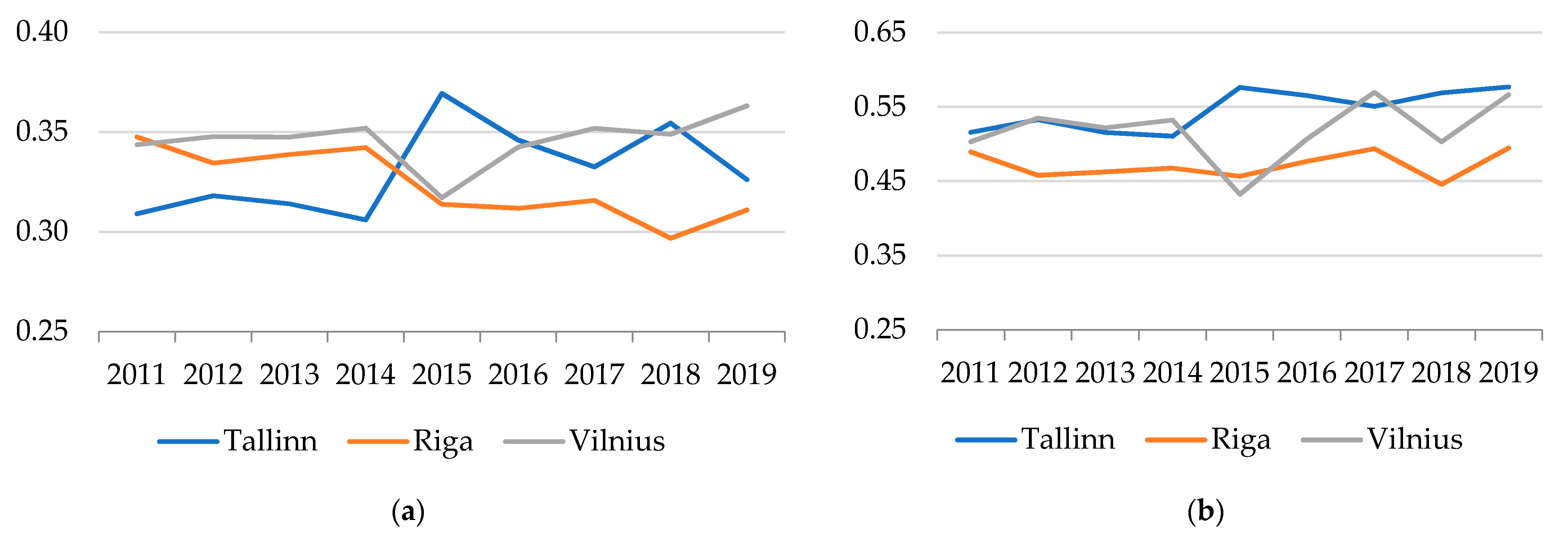
| COPRAS | ||||||||||||||||||
| 2011 | 2012 | 2013 | 2014 | 2015 | 2016 | 2017 | 2018 | 2019 | ||||||||||
| Tallinn | 0.31 | 1 | 0.32 | 3 | 0.31 | 3 | 0.31 | 3 | 0.37 | 1 | 0.35 | 1 | 0.33 | 2 | 0.35 | 1 | 0.33 | 2 |
| Riga | 0.35 | 2 | 0.33 | 2 | 0.34 | 2 | 0.34 | 2 | 0.31 | 3 | 0.31 | 3 | 0.32 | 3 | 0.30 | 3 | 0.31 | 3 |
| Vilnius | 0.34 | 3 | 0.35 | 1 | 0.35 | 1 | 0.35 | 1 | 0.32 | 2 | 0.34 | 2 | 0.35 | 1 | 0.35 | 2 | 0.36 | 1 |
| Correl | 1 | 1 | 1 | 1 | 1 | 1 | 1 | 1 | 1 | |||||||||
| SAW | ||||||||||||||||||
| 2011 | 2012 | 2013 | 2014 | 2015 | 2016 | 2017 | 2018 | 2019 | ||||||||||
| Tallinn | 0.52 | 1 | 0.53 | 2 | 0.52 | 2 | 0.51 | 2 | 0.58 | 1 | 0.57 | 1 | 0.55 | 2 | 0.57 | 1 | 0.58 | 1 |
| Riga | 0.49 | 3 | 0.46 | 3 | 0.46 | 3 | 0.47 | 3 | 0.46 | 2 | 0.48 | 3 | 0.49 | 3 | 0.45 | 3 | 0.49 | 3 |
| Vilnius | 0.50 | 2 | 0.53 | 1 | 0.52 | 1 | 0.53 | 1 | 0.43 | 3 | 0.51 | 2 | 0.57 | 1 | 0.50 | 2 | 0.57 | 2 |
| 1 | 1 | 1 | 1 | 1 | 1 | 1 | 1 | 1 | ||||||||||
| Correl | −0.90 | −0.03 | −0.17 | 0.02 | 0.98 | 0.82 | 0.95 | 0.89 | 0.64 | |||||||||
| GM | ||||||||||||||||||
| 2011 | 2012 | 2013 | 2014 | 2015 | 2016 | 2017 | 2018 | 2019 | ||||||||||
| Tallinn | 0.40 | 3 | 0.41 | 3 | 0.40 | 3 | 0.39 | 3 | 0.47 | 1 | 0.46 | 2 | 0.46 | 2 | 0.46 | 2 | 0.47 | 2 |
| Riga | 0.44 | 1 | 0.43 | 2 | 0.43 | 2 | 0.44 | 2 | 0.41 | 2 | 0.43 | 3 | 0.45 | 3 | 0.39 | 3 | 0.45 | 3 |
| Vilnius | 0.43 | 2 | 0.45 | 1 | 0.44 | 1 | 0.45 | 1 | 0.40 | 3 | 0.47 | 1 | 0.51 | 1 | 0.47 | 1 | 0.53 | 1 |
| Correl | 0.99 | 1.00 | 1.00 | 1.00 | 0.99 | 0.95 | 0.95 | 0.99 | 1.00 | |||||||||
| COPRAS | SAW | GV | |
|---|---|---|---|
| Cities | Mean 2011–2019 | Mean 2011–2019 | Mean 2011–2019 |
| Tallinn | 2 | 1 | 2–3 |
| Riga | 3 | 3 | 2–3 |
| Vilnius | 1 | 2 | 1 |
| City | Quality of Life Index | Safety Index | Health Care Index | Cost of Living Index | Property Price to Income Ratio | Pollution Index | Crime Index |
|---|---|---|---|---|---|---|---|
| Tallinn | 168.65 | 77.50 | 71.28 | 59.20 | 9.74 | 22.58 | 22.50 |
| Vilnius | 165.21 | 72.41 | 75.10 | 48.79 | 11.05 | 23.50 | 27.59 |
| Riga | 142.27 | 62.07 | 60.73 | 55.43 | 9.59 | 38.34 | 37.93 |
| City | Numbeo Index | Homicide Rate City | Global Peace Index | Security Risk | Natural Disaster Risk | Road Traffic Death Rate | Homicide Rate Country |
|---|---|---|---|---|---|---|---|
| Tallinn | 79.48 | 2.5 | 0.72 | 0.25 | 2.36 | 7 | 4.4 |
| Riga | 62.62 | 4 | 0.74 | 0.25 | 3.31 | 10 | 6.7 |
| Vilnius | 70.82 | 3 | 0.72 | 0.25 | 2.92 | 10.6 | 6.8 |
Publisher’s Note: MDPI stays neutral with regard to jurisdictional claims in published maps and institutional affiliations. |
© 2021 by the authors. Licensee MDPI, Basel, Switzerland. This article is an open access article distributed under the terms and conditions of the Creative Commons Attribution (CC BY) license (https://creativecommons.org/licenses/by/4.0/).
Share and Cite
Činčikaitė, R.; Meidute-Kavaliauskiene, I. Assessment of Social Environment Competitiveness in Terms of Security in the Baltic Capitals. Sustainability 2021, 13, 6932. https://doi.org/10.3390/su13126932
Činčikaitė R, Meidute-Kavaliauskiene I. Assessment of Social Environment Competitiveness in Terms of Security in the Baltic Capitals. Sustainability. 2021; 13(12):6932. https://doi.org/10.3390/su13126932
Chicago/Turabian StyleČinčikaitė, Renata, and Ieva Meidute-Kavaliauskiene. 2021. "Assessment of Social Environment Competitiveness in Terms of Security in the Baltic Capitals" Sustainability 13, no. 12: 6932. https://doi.org/10.3390/su13126932
APA StyleČinčikaitė, R., & Meidute-Kavaliauskiene, I. (2021). Assessment of Social Environment Competitiveness in Terms of Security in the Baltic Capitals. Sustainability, 13(12), 6932. https://doi.org/10.3390/su13126932







